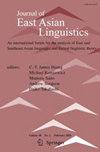越南语中的阻断效应
IF 0.5
3区 文学
0 LANGUAGE & LINGUISTICS
引用次数: 0
摘要
本文探讨了越南语对非本地绑定的限制-阻塞效应-包括与普通话对应的系统比较。我们的研究发现,越南语的阻滞效应与汉语的阻滞效应有很大的不同,但实际上,它们采用的是基本相同的句法机制。汉语子词的绑定是由[+参与者]控制的,而越南语暗喻mình的绑定是由[+作者]控制的。再加上假设存在一个沉默的表演框架,这就得出了越南语mình的绑定产生了我们所谓的作者效应。本文章由计算机程序翻译,如有差异,请以英文原文为准。
The blocking effect in Vietnamese
This article explores a restriction on non-local binding in Vietnamese—the blocking effect—including a systematic comparison with its Mandarin Chinese counterpart. Our finding is that the blocking effect in Vietnamese appeared to be rather different from that in Mandarin but, in fact, employs essentially the same syntactic mechanism. While binding of Mandarin ziji is governed by a [+participant] feature, binding of the Vietnamese anaphor mình is governed by a [+author] feature. Together with the assumption of the presence of a silent performative frame, this derives that binding of Vietnamese mình yields what one may call an Author effect.
求助全文
通过发布文献求助,成功后即可免费获取论文全文。
去求助
来源期刊

Journal of East Asian Linguistics
Multiple-
CiteScore
0.90
自引率
0.00%
发文量
13
期刊介绍:
The study of East Asian languages, especially of Chinese, Japanese and Korean, has existed for a long time as a field, as demonstrated by the existence of programs in most institutions of higher learning and research that include these languages as a major component. Speakers of these three languages have shared a great deal of linguistic heritage during the development of their languages through cultural contacts, in addition to possible genealogical linkage. These languages accordingly possess various common features. Another important factor that ties them together as a field is that they have shared a common tradition of linguistic scholarship, a tradition that distinguishes itself from the study of western languages. Against this tradition, much recent work has approached these languages from a broader perspective beyond the area, considering them within contexts of general theoretical research, bringing new lights to old problems in the area and contributing to current issues in linguistic theory. But there continues to be good reason for scholars working in this approach to hold a special interest in each other''s work. Especially with the amount of most recent theoretical work on these languages, the field of theoretical East Asian linguistics has been fast growing. The purpose of the Journal of East Asian Linguistics is to provide a common forum for such scholarly activities, and to foster further growth that will allow the field to benefit more from linguistic theory of today, and enable the languages to play a more important role in shaping linguistic theory of tomorrow.
 求助内容:
求助内容: 应助结果提醒方式:
应助结果提醒方式:


